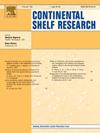Zooplankton of the Kara Sea in early spring: Abundance, demography, feeding and reproduction of dominant copepods Calanus spp. and Metridia longa in relation to ice retreat
IF 2.2
3区 地球科学
Q2 OCEANOGRAPHY
引用次数: 0
Abstract
Most dramatic environmental changes in the Arctic seas occur in spring, with timing of ice melt, increase of water temperature and food concentration decisive for the reproduction and recruitment success of the large copepods. In the Kara Sea, most of the studies on zooplankton community were performed at the end of the productive season. The main goal of this study is to gain knowledge on distribution, demography, grazing and reproduction of the dominant zooplankton species in the Kara Sea in early spring soon after ice retreat. Zooplankton were collected, feeding and reproduction rates studied along the retreating ice edge over the Kara Sea shelf and in the St. Anna Trough from 22 to June 30, 2021. All studied copepod species, despite different overwintering and life cycle strategies, responded similarly to the timing of ice retreat. An earlier ice melt led to higher abundance and an advanced demographical structure of the populations of dominant copepods, Calanus glacialis, C. finmarchicus, C. hyperboreus and Metridia longa. Egg production of C. glacialis and C. finmarchicus was high in the areas where the ice has recently melted. Spawning of C. finmarchicus females and presence of early developmental stages over the Kara Sea shelf suggests successful local recruitment of this basically boreal species. Daily rations of three Calanus species were high irrespective of phytoplankton concentration which indicates considerable exploitation of alternative food sources during spring post-bloom situations. Fairly low grazing impact on phytoplankton suggests that copepods community does not control spring development of phytoplankton and most part of the newly produced organic matter would be available for benthos.
喀拉海早春浮游动物:优势桡足类、长足类与冰退相关的丰度、数量、摄食和繁殖
北极海域最剧烈的环境变化发生在春季,冰融化的时间、水温的升高和食物浓度对大型桡足类动物的繁殖和招募成功起着决定性的作用。在喀拉海,对浮游动物群落的研究大多在生产季节结束时进行。本研究的主要目的是了解喀拉海优势浮游动物在海冰消退后初春的分布、人口、放牧和繁殖情况。从2021年6月22日至30日,在喀拉海陆架和圣安娜海槽的退缩冰边缘收集浮游动物,研究其摄食和繁殖率。所有被研究的桡足类物种,尽管越冬和生命周期策略不同,但对冰退缩时间的反应相似。较早的冰融化导致优势桡足类(Calanus glacialis)、C. finmarchicus、C. hyperboreus和Metridia longa)种群的丰度更高,种群结构也更先进。在最近冰融化的地区,冰锥蝽和冰锥蝽的产卵量很高。在喀拉海大陆架上产卵和早期发育阶段的存在表明,这种基本上是北方的物种在当地成功地招募了。无论浮游植物的浓度如何,三种Calanus的日口粮都很高,这表明在春季开花后的情况下,有相当多的替代食物来源被利用。放牧对浮游植物的影响较低,表明桡足类群落不控制浮游植物的春季发育,大部分新产生的有机物可供底栖动物利用。
本文章由计算机程序翻译,如有差异,请以英文原文为准。
求助全文
约1分钟内获得全文
求助全文
来源期刊

Continental Shelf Research
地学-海洋学
CiteScore
4.30
自引率
4.30%
发文量
136
审稿时长
6.1 months
期刊介绍:
Continental Shelf Research publishes articles dealing with the biological, chemical, geological and physical oceanography of the shallow marine environment, from coastal and estuarine waters out to the shelf break. The continental shelf is a critical environment within the land-ocean continuum, and many processes, functions and problems in the continental shelf are driven by terrestrial inputs transported through the rivers and estuaries to the coastal and continental shelf areas. Manuscripts that deal with these topics must make a clear link to the continental shelf. Examples of research areas include:
Physical sedimentology and geomorphology
Geochemistry of the coastal ocean (inorganic and organic)
Marine environment and anthropogenic effects
Interaction of physical dynamics with natural and manmade shoreline features
Benthic, phytoplankton and zooplankton ecology
Coastal water and sediment quality, and ecosystem health
Benthic-pelagic coupling (physical and biogeochemical)
Interactions between physical dynamics (waves, currents, mixing, etc.) and biogeochemical cycles
Estuarine, coastal and shelf sea modelling and process studies.
 求助内容:
求助内容: 应助结果提醒方式:
应助结果提醒方式:


